Parts of Flower | Botany - Androecium | 11th Botany : Chapter 4 : Reproductive Morphology of Angiosperm
Chapter: 11th Botany : Chapter 4 : Reproductive Morphology of Angiosperm
Androecium
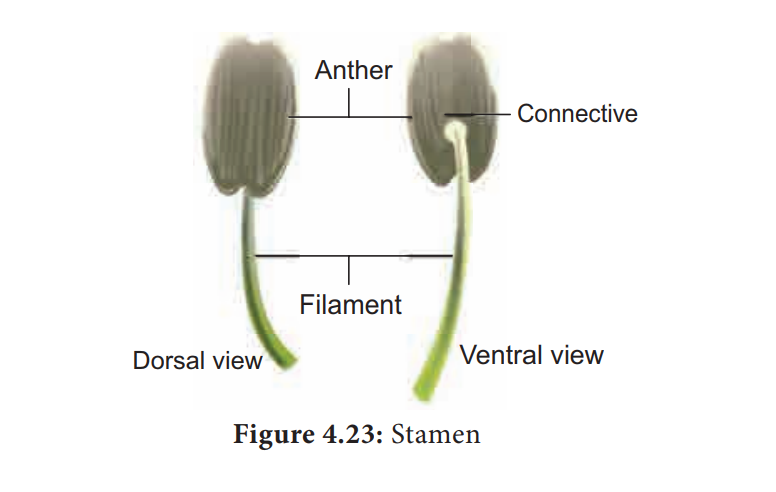
Essential Parts of Flower
Androecium
Androecium: Third whorl of flower is the male
reproductive part of the flower. It is composed of stamens(microsporophylls).
Each Stamen consist of 3 parts, a. Filament b. Anther c. Connective
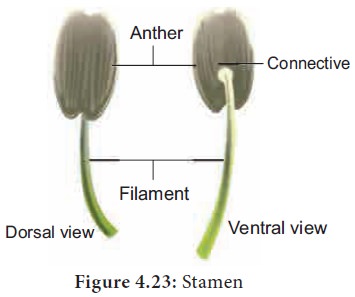
Anther: Upper swollen part with mi-crosporangia.
Filament: Stalk
of stamen
Connective: Tissue
connecting anther lobes with
filament
Anther typically contains two com partments called
thecae (singular theca). Each theca
consists of two microsporangia. Two microsporangia fused to form a locule.
Sterile stamens are called Staminodes. Example: Cassia.
Distinct: stamens which do not fuse
to one another. Free: stamens which
do not fuse with other parts of flower. Apostemonous:
flowers with stamens that are free and distinct.
1. Fusion of stamens:
Refers to the stamens fusing among
themselves or with other parts of flower. Two types![]()
![]()
Connation
and 2. Adnation
1.
Connation: Refers to the fusion of stamens among themselves. It is of 3 types.
a. Adelphy.
b. Syngenecious. c. Synandrous.
a.
Adelphy: Filaments connate into one
or more bundles but anthers are free. It may be the following types.
1.
Monadelphous: Filaments of
stamens connate into a single bundle. Example: malvaceae
(chinarose,cotton).

2.
Diadelphous: Filaments of stamens connate into two bundles.
Example: Fabaceae, pea.
3.
Polyadelphous: Filaments connate into many bundles. Example: Citrus,
Bombax
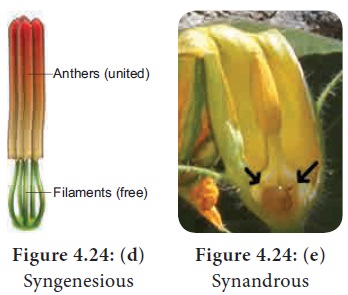
b.
Syngenesious: Anthers connate, filaments free. Example:
Asteraceae.
c.
Synandrous: Filaments and anthers are completely fused.
Example: Coccinea.
2. Adnation: Refers to the fusion of stamens with other floral parts. Epipetalous (petalostemonous): Stamens are adnate to petals .Example: brinjal,Datura.
a.
Episepalous: stamens are adnate to sepals. Example: Grevillea
(Silver oak) Stamen
b.
Epitepalous Petal ( epiphyllous ) : stamens
are adnate to tepals. Example: Asphodelus, Asparagus.
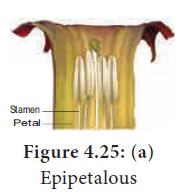
c.
Gynostegium:Connation product of stamens and stigma is called gynostegium.
Example: Calotropis and Orchidaceae.
d.
Pollinium: Pollen grains are fused together
as a single mass
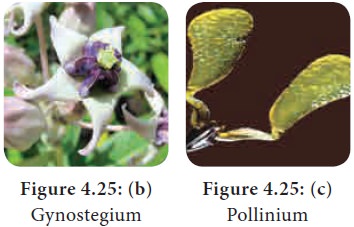
2. Arrangement of stamens relate to length of stamens:
1.
Didynamous (di-two, dynamis-strength): Four stamens in which two with long filaments and two with short
filaments. Example: Lamiaceae, Ocimum.
If all four stamens are in two equal pairs then the condition is called didynamous.
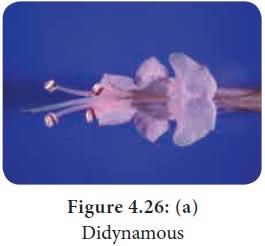
2.
Tetradynamous(tetra-four): Six sta-mens of which four with long filaments
and two with short filaments. Example: Brassi-caceae, (Brassica).
3.
Heterostemonous: stamens are of different lengths in the same flower. Example: Cassia, Ipomoea.
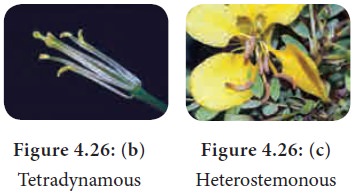
3. Stamen insertion
1. Inserted: Shorter
than the corolla tube and included within. Example: Datura.
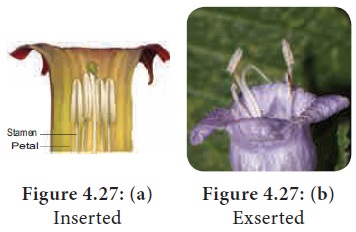
2.Exserted:Longer
than the corolla tube and project
out.Example: Mimosa, Acacia arabica
The number of whorls of stamens present in a flower
is called stamen cycly. Two major
types are 1.uniseriate,a single
whorl of stamens and 2.biseriate,two
whorls of stamens.
4. Anther types
1. Monothecal: One
lobe with two microsporangia. They
are kidney shaped in a cross section. Example: Malvaceae
2. Dithecal: It is a typical type,having two lobes with four microsporangia.They are butterfly shaped in cross section. Example: solanaceae.
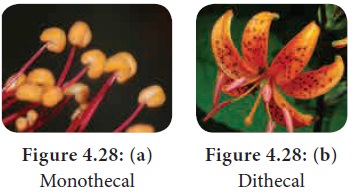
Someothertypes:
a) Haplostemonous: stamens are
uniseriate and equal in number to the petals and opposite the sepals
(antisepalous)
b)
Obhaplostemonous: Stamens are uniseriate, number equal to petals
and opposite the petals (antipetalous)
c)
Diplostemonous: Stamens are biseriate, outer antisepalous, inner
antipetalous. Example: Murraya.
d)
Obdiplostemonous: Stamens are biseriate, outer antipetalous,
inner antisepalous.Example:Caryophyllaceae.
e) Polystemonous: Numerous sta-mens
are normally many more than the number of petals.
5.
Anther attachment
1. Basifixed:(Innate)
Base of anther is attached to the
tip of filament. Example: Brassica,
Datura.
2. Dorsifixed: Apex of
filament is attached to the dorsal
side of the anther. Example: Citrus,
Hibiscus.
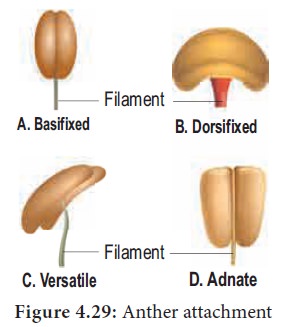
3. Versatile:
Filament is attached to the anther
at midpoint. Example: Grasses.
4. Adnate:
Filament is continued from the base
to the apex of anther. Example: Verbena,
Ranunculus, Nelumbo
6. Anther dehiscence
It refers to opening of anther to disperse pollen
grains.
i
Longitudinal: Anther
dehisces along a suture parallel to
long axis of each anther lobe. Example: Datura,
chinarose, cotton.
ii
Transverse: Anther
dehisces at right angles to the long
axis of anther lobe. Example: Malvaceae.
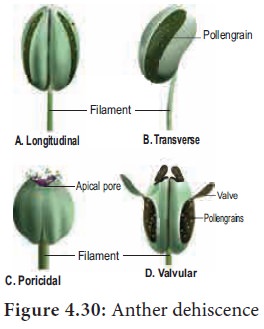
iii
Poricidal: Anther
dehisces through pores at one end of
the thecae. Example: Ericaceae, Solanum,
potato, brinjal, Cassia.
iv. Valvular: Anther
dehisces through a pore covered by a
flap of tissue. Example: Lauraceae, Cinnamomum.
7. Anther dehiscing direction
It shows the position of anther opening relative to
the anther of the flower.
1. Introrse: Anther
dehisces towards the center of the flower. Example: Dianthus.
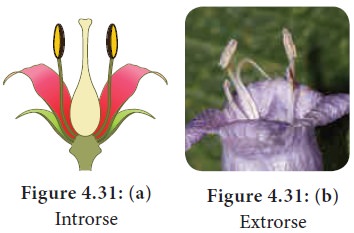
2. Extrorse: Anther
dehisces towards pe-riphery of the flower. Example: Argemone.
Related Topics